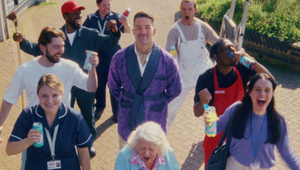
Super Shoots: A Secret Weapon for Sustainability and Commercial Benefit

It's thought that a single day of film production typically generates 2.2 tonnes of carbon - that's roughly the same as taking two round-trip flights from London to New York or eating 1,000 quarter-pound beef burgers! In an era of increasing environmental awareness, brands are under pressure to minimise their footprint. But what if you could simultaneously reduce your environmental impact and boost your marketing ROI?
It’s no secret that any shoot that requires travel will fast become a carbon intensive production method. While all our Hogarth producers are very diligent at reducing on set emissions, when you need to travel halfway around the world to capture content there is only so much you can reduce. Eliminating single use plastic, minimising waste, sourcing local materials, opting for plant-based catering all seem academic when in comparison to the emissions associated with travel. In fact, these methodologies resulted in Hogarth's first award win for sustainable production in the 2024 Campaign Ad Net Zero award for Best Practice in Sustainable Ad Production. However, the balance of representing brands in beautiful, culture rich settings and sustainability are not without its challenges.
A more strategic approach to content production is to encourage our clients to think about a year of production instead one production after another. With a slight shift in planning, we start to think about what the entire years’ worth of scope looks like. This holistic approach unlocks opportunities for optimization and a move towards super shoots. For the purpose of this piece, I am defining super shoots as single location, integrated shoots, designed to capture a wide range of production ready assets intended for use in multiple channels and campaigns.
The commercial benefits of planning a super shoot are significant, including reduced resourcing costs, bulk purchasing power, consolidated travel expenses, and streamlined set construction. While commercial and sustainability benefits are often viewed separately, super shoots offer a unique opportunity to achieve both. Capturing production-ready assets for multiple products allows us to streamline the entire production process.
By engaging with local, diverse crew and talent, we drive authenticity through our content whilst making a positive impact on local economies. Both of which allow us to represent brands more fairly and help support local communities in a more meaningful way. The most impactful lever is travel, and by shooting once and travelling once we reduce emissions related to travel.
At Hogarth, we leverage a global network to deliver on super shoots by ensuring single, global ways of working to make for a smooth transition between stages of the workflow. This is where technology and infrastructure must play a part in any super shoot to streamline workflow and mobilise assets, pushing them to the next production teams in the process. We utilise cloud-based solutions and ensure that the assets our teams are creating deliver against a clear media plan. A tightly cropped asset saved on a physical hard drive will be less versatile than an asset shot in a variety of aspect ratios, angles and formats saved in a single cloud-based repository.
All of this allows cross divisions to collaborate and create assets at speed. In the future we will also be looking to drive automation and continually exploring AI technology to support on creating high quality assets, ensuring asset utilisation is high and therefore footprint by asset is reduced.
“It is estimated that about $5.5 billion is spent annually on content that never gets utilised, with approximately 70% of content never being used and 35% of ads duplicated.*”
Many people don’t immediately consider the impact of data storage within production. Once the shoot is complete and requested assets have been generated, we ensure assets are resurfaced for reuse. Any production company will have an asset retention policy but what is unique is that at Hogarth we can store and appropriately tag assets with relevant keywords making them easily searchable and reusable. By using AI-powered tagging, we can ensure that even unused footage is easily searchable and repurposed for future campaigns, minimising the need for new shoots. Clients in sectors such as Food & Beverage and Automotive, have experienced the considerable value in repurposing assets for future campaigns, both at a commercial level but also an environmental level.
If we can minimise the frequency of shoots, we minimise the emissions. It also allows us to react and create content much quicker. The more we utilise content, the footprint associated with the creation of it spreads over a larger number of assets and therefore reduces.
The constant production challenge is to create more, at a higher quality than ever, for less.
A super shoot approach could allow us to do exactly that whilst benefitting from reduced emissions too! Unlocking the full potential of integrated production can help us totally transform the way we partner with our clients at scale.















